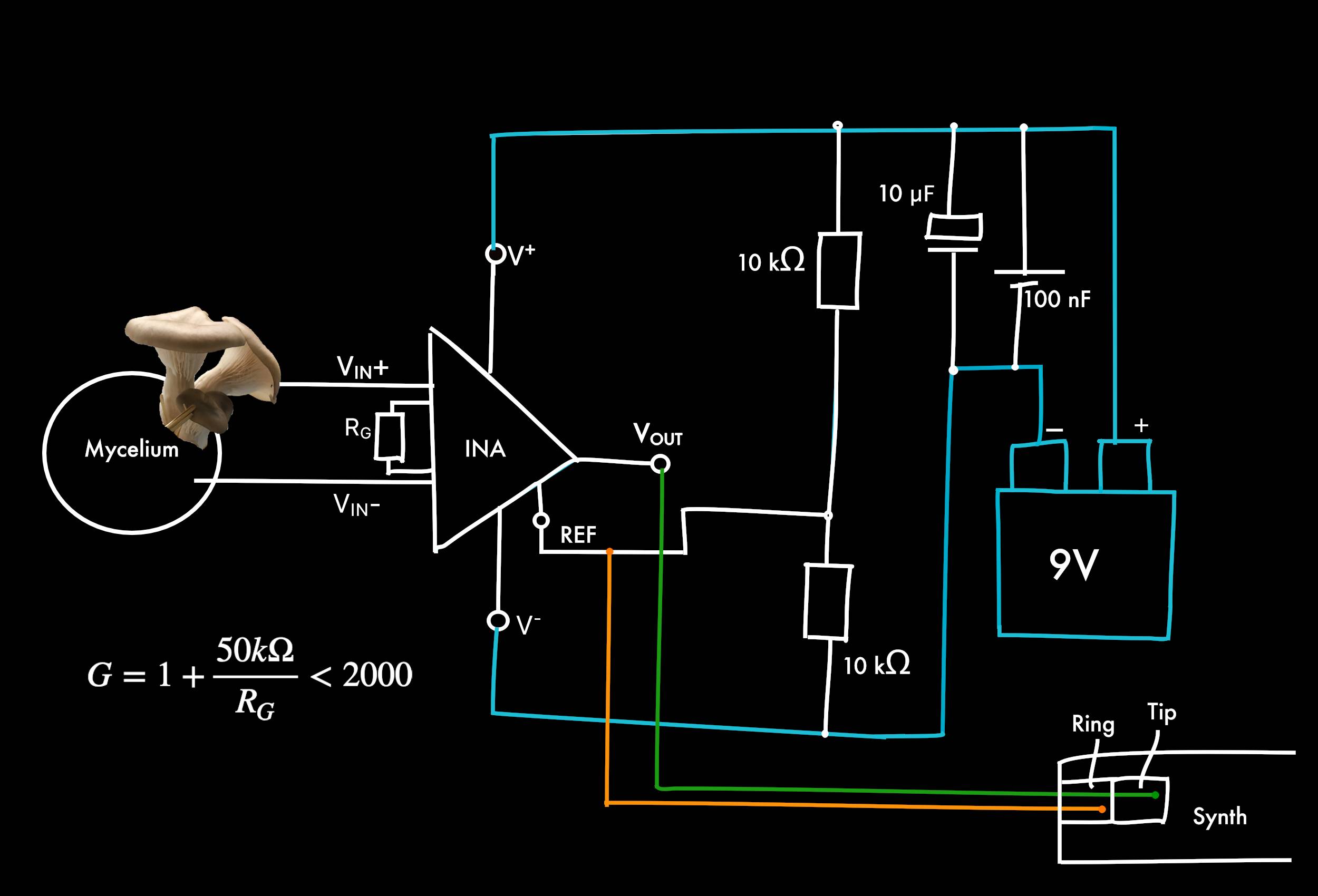Bioelectronic Music
- Talking With Fungi -
In Progress
Introduction
This art and research project deals with sonification of the bioelectricity of organisms. Plants, animals and fungi use electrical signals to conduct information. Prof. Andrew Adamatzky from the Unconventional Computing Laboratory of the University of the West of England hypothysizes that fungi communicate with each other through their electrical impulses by clustering their activity1.
This project is inspired from previously developed synthesizers3,4, which direct the electrical pulses into the SCÍON4 module, a module for modular synthesizers or the MIDI Sprout Tool5 to translate them into MIDI notes. In contrast to these methods, however, I am working independently from an existing module and measure, amplify and route the bioelectric signals to a CV IN of a synthesizer autonomously. The incentive for this is that, on the one hand, I think that translating the impulses into MIDI notes might not do justice to the variability of the signals, and on the other hand, I want to learn about electronics and use this project as an introduction to getting to grips with it.
Concept

The current setup of the circuit described in this figure starts with the measurement of the voltage ratio between the fruiting body and the mycel. Alternatively, the fruiting bodies’ cap and stalk can also be used for recording the electrical potential difference, as done in the publication by Andrew Adamatzky from 20186, which describes that two frequencies were detected, a slow and a fast frequency with an average amplitude of 0.88mV and 1.3mV, respectively.
Based on this, the gain provided by the instrumentation amplifier (INA) must be selected. This can be regulated by the corresponding resistor RG. If the amplification of an instrumentation amplifier is not sufficient, an operational amplifier would also need to be connected. The reference is generated from by virtual voltage between two resistors and fed into a jack plug together with the measured voltage at the Vout of the instrumentation amplifier. In addition, a regulation of the input voltage is to be built in, in order not to conduct possible sudden high voltage spikes into the synthesizer. Likewise, via an analog-to-digital converter and a wifi micro-processor like the ESP-32 the signals could be transmitted to a DAW and mixed or recorded there.
Based on this, the gain provided by the instrumentation amplifier (INA) must be selected. This can be regulated by the corresponding resistor RG. If the amplification of an instrumentation amplifier is not sufficient, an operational amplifier would also need to be connected. The reference is generated from by virtual voltage between two resistors and fed into a jack plug together with the measured voltage at the Vout of the instrumentation amplifier. In addition, a regulation of the input voltage is to be built in, in order not to conduct possible sudden high voltage spikes into the synthesizer. Likewise, via an analog-to-digital converter and a wifi micro-processor like the ESP-32 the signals could be transmitted to a DAW and mixed or recorded there.
Motivation
The motivation for me is to translate the electrical impulses into sound in order to find a contact to the communication level of the mushrooms with the help of music as a universal language. For me, this leads to the following research questions that I would like to explore:
How do fungi react to environmental variables?
Do fungi react to music?
Do fungi respond to different types of music?
Do fungi have a personal taste in music?
Are fungi musical? Do their electrical impulses adapt to music?
Can fungi and humans communicate through music, or create music together?
Evolution
The interest I have in this project has turned to the transfer of bio-signals into my synthesizer, as I have learned that the bio-electrical signals of mushrooms are so small that a lot of other signals are transferred when they are amplified. Therefore, I focused on amplifying my own muscle movements and using them as CV input for the KORG Volca Modular.